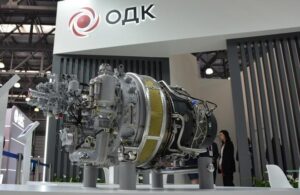JSC “UEC-Klimov,” an engine manufacturing company, has been issued a type certificate for the VK-650V turboshaft engine, which is intended for light helicopters with a takeoff weight of up to four tons. Dmitry Yadrov, the chief of the Federal Air Transport Agency (Rosaviatsiya), presented the necessary document to Alexander Grachev, the General Director of UEC, in St. Petersburg. Anton Alikhanov, the Minister of Industry and Trade of the Russian Federation, and Vladimir Artyakov, the First Deputy General Director of Rostec, were in attendance at the ceremony.
The VK-650V’s certification means that the engine’s design satisfies defined airworthiness standards and requirements, thereby enabling its mass production. The VK-650V, which is designed to replace the Ansat and Ka-226T helicopter engines, as well as other light helicopters, has been in development since 2019. It has a power class of 650–750 horsepower. In July 2019, the certification application was submitted to Rosaviatsiya.
Vladimir Artyakov said, “An aircraft engine is the most complex component of an aircraft. The development and certification of the VK-650V were completed in record time—just five years. The demand for such power units has significantly increased with the introduction of sanctions and the withdrawal of foreign suppliers. Today, we can say that our engine manufacturers have successfully tackled this challenging task. Alongside new engines for heavy and medium helicopters, we now have our own domestic engine for light helicopters. This means that sanctions could not destroy the Ansat and other promising projects.”
The VK-650V is certified in a configuration that provides 545 horsepower in takeoff mode, as indicated by the type certificate data sheet FATA-01065E, which was initially issued on December 28, 2024. The power output is 460 horsepower in maximum continuous mode and 400 horsepower in cruise mode. The VK-650V generates 630 horsepower in a 2.5-minute emergency mode with one engine inoperative, and 590 horsepower in continuous emergency power mode.
It is expected that the engine’s power will be increased to its intended levels, which are 650 horsepower in takeoff mode and 750 horsepower in a 2.5-minute emergency mode, by obtaining approvals for significant modifications following additional certification tests. The VK-650V engine is currently approved for use, but it needs its first maintenance check after a short period. The free turbine shaft is expected to last for almost 75 hours before needing replacement. Other important parts are designed to last for 100 cycles (uses) before needing service.
The VK-650V program is being carried out in collaboration with other United Engine Corporation companies, such as MMP named after V.V. Chernyshev, UEC-UMPO, and PC “Salut” UEC. A comprehensive approach to the project’s implementation is guaranteed by the involvement of these companies in the production of individual components and assemblies.
The VK-650V demonstrator engine began development in January 2021, and the initial prototype was completed by the end of the same year. Two additional prototypes were manufactured in 2022. The compressor and combustion chamber underwent autonomous testing in collaboration with the Central Institute of Aviation Motors (CIAM) by May 2023, following the completion of engineering tests.
A mock-up of the VK-650V was presented at the “Army” forum in August 2024 as a component of the first modified Ka-226T “Alpinist” helicopter, which was produced by the Ulan-Ude Aviation Plant. Furthermore, the modernized light single-engine Mi-34M1 helicopter underwent VK-650V tests in October of last year.
April 2025 is the expected date for the first flight of the Ansat helicopter, which is equipped with the VK-650V engine. The director of Rosaviatsia, Dmitry Yadrov, disclosed this information during the ceremony for the transfer of the type certificate. He said efforts are presently being made to certify an import-substituted version of the helicopter.
Dmitry Yadrov said, “A number of bench tests have already been completed, including static strength tests of the rotor blade. Therefore, we plan to finish this work by the end of the year, and the first flight is scheduled for April this year to complete all these tasks.”
The first eight serial VK-650V engines are scheduled for production this year, as indicated by the most recent edition of the Comprehensive Program for the Development of the Aviation Industry until 2030. It is anticipated that the production volume will progressively increase to 70 engines per year in the future.
Official Website of Youtube Channel – Altitude Addicts


